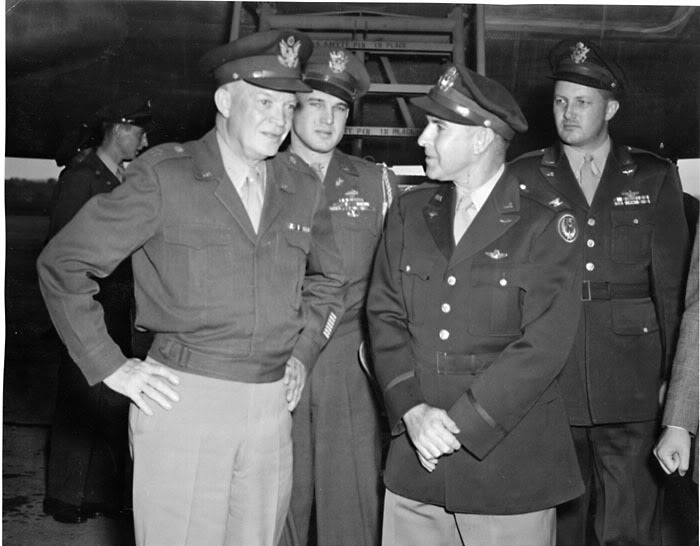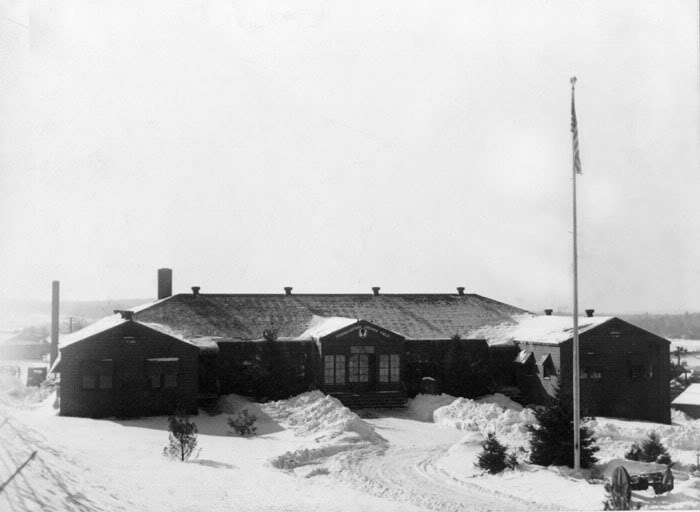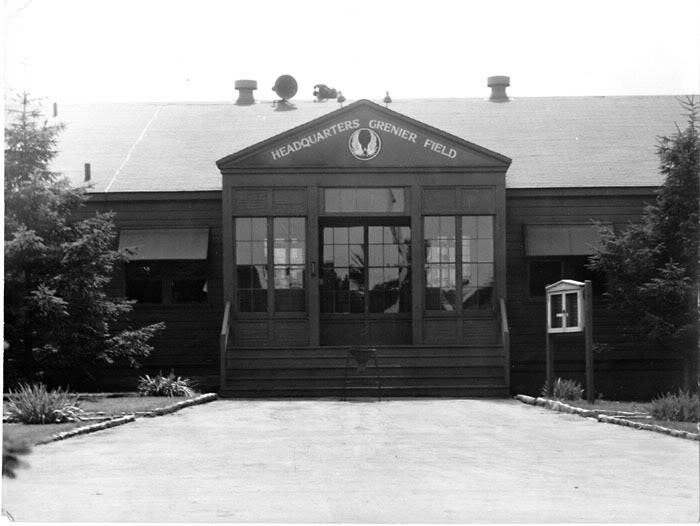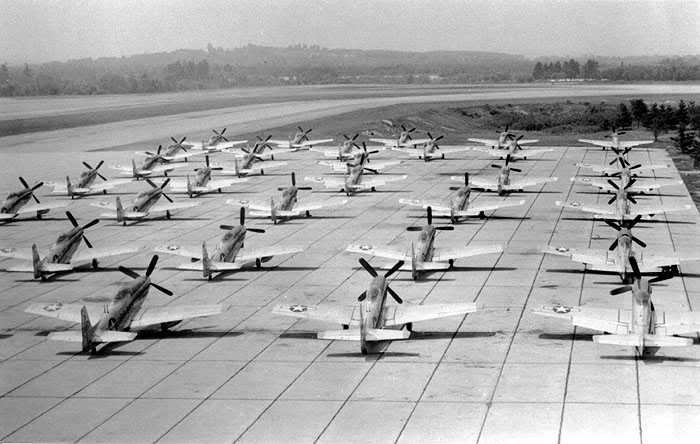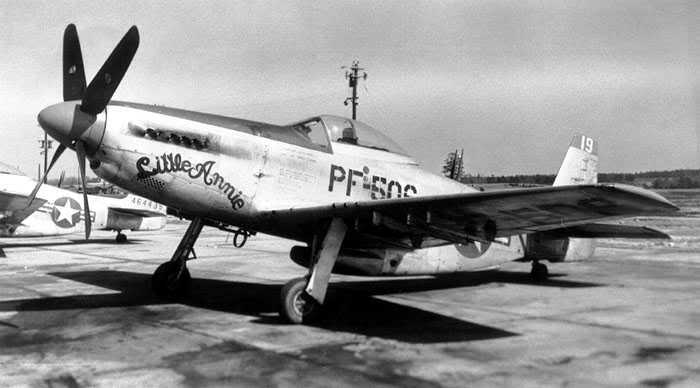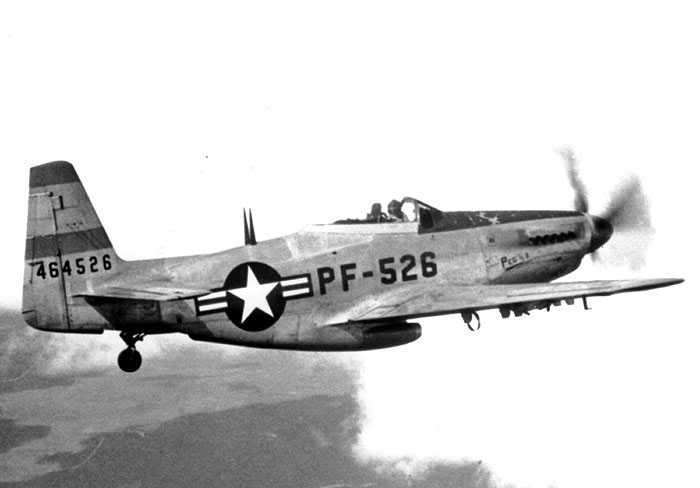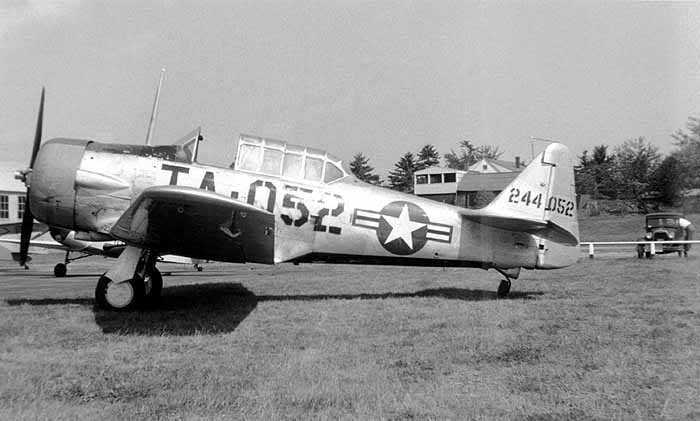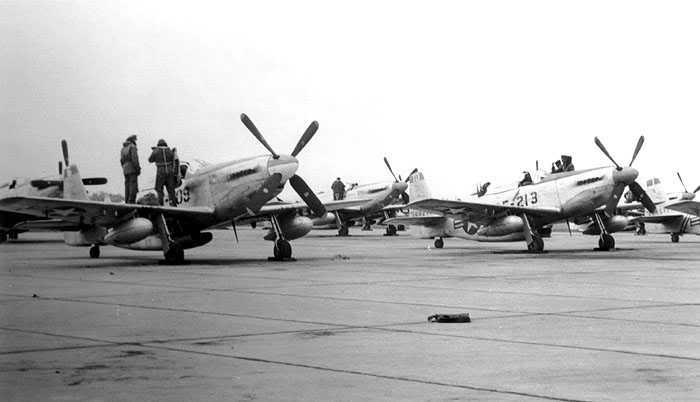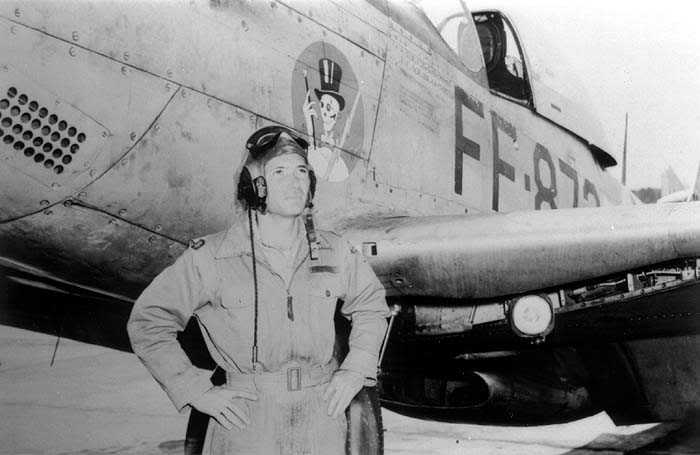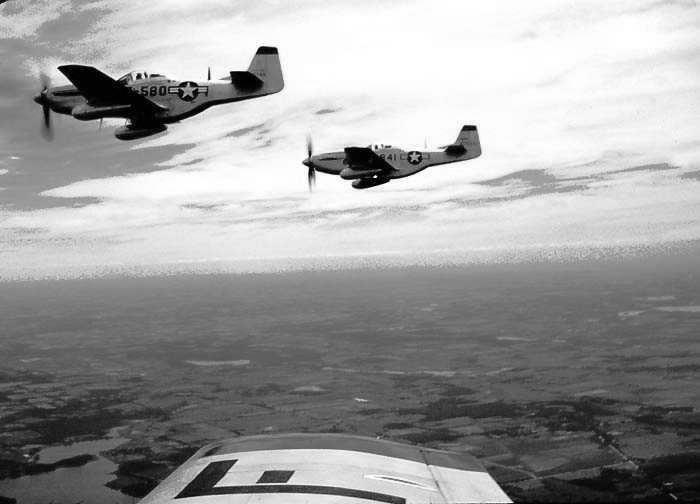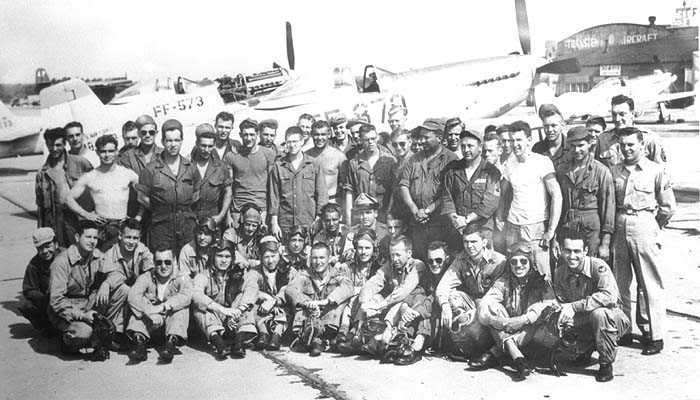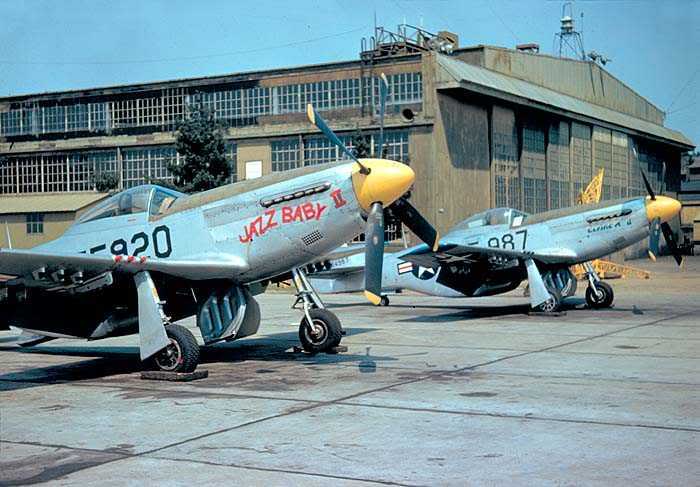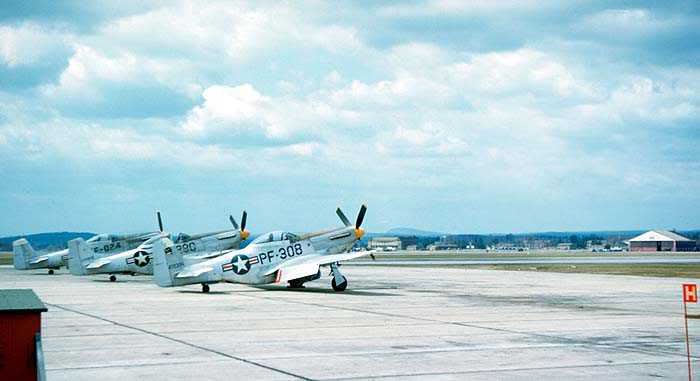|
The 82nd FG (Fighter Group) was activated on 22 Apr 47 in accordance with War Dept. Letter AGAO-I322 dated 26 Mar 47 and AFCOR 440-e dated 7 Apr 47. Purpose of Group is to train in Very Long Range (VLR) Fighters, Twin Engine. Group to be comprised of 95th Fighter Squadron (FS), 96th FS and 97th FS. Maj. Leland R. Raphaun assigned as group commanding officer.
05 May 47-95th FS activated per General Order (GO) 4, Headquarters (HQ) 66 Combat Fighter Wing (CFW).
02 Jun 47-Lt. Col. Gerald W. Johnson assumed command of 82nd FG.
11 Jun 47-95th FS became operational under command of Maj. Leland R. Raphaun.
14 Jun 47-97th FS became operational under command of Maj. Julius D. Shivers.
16 Jun 47-96th FS became operational under command of Maj. William F. Wilkerson.
30 Jun 47-Group Personnel strength this date 111 officers and 390 enlisted men. Additional troops coming from Selfridge Army Air Base (AAB), MI., Lowry AAB, CO., and Chanute AAB, IL.
Upcoming change in mission to single engine fighter has caused some twin-engine rated officers to travel from Kearny, NE to Grenier AAB, then back to Kearny.
82nd FG expansion hindered by lack of supplies, publications and regulations.
14 Jul 47-Col. Henry Viccellio assumed command 82nd FG, Lt. Col. Johnson assigned as group vice commander.
21 July 47-97th FS moved to old WAC area on “other side” of field. This brings squadron resources closer to their assigned hangar.
Part supply remains large problem, caused up to 16 F-51H Mustangs of 25 assigned thus far to be Out of Commission Parts (AOCP). Pilots were flying without helmets, gloves or flying suits, while only 44 parachutes were available for 125 pilots.
Most officers that arrived were rated pilots that had recently returned to military life. Many had WWII combat experience. Many officers and enlisted men arrived at Grenier from 62nd FS, a unit that had just returned from a winter test in Alaska.
82nd FG History August 1947 H-H-501-135A
01 Aug 47-All three of the group's fighter squadrons were redesignated as fighter, single-engine per AGAO-I322/AFCOR (538c)-M.
Pilots were required to ferry P-51 aircraft from Kelly AAB, TX to Great Falls, MT. Other group personnel were on temporary duty (TDY) at Salinas, KS to help B-29 group with gunnery training.
19 Aug 47-25 officer and 100 enlisted men under command of Maj. Leland R. Raphaun transferred from 95th FS to 33rd FG at Roswell AAB, NM to become cadre for force buildup there.
95th FS-flew 474 hours during month. Averaged 12 P-51H aircraft in commission daily.
96th FS-flew 401 hours during month. Averaged 12 P-51H aircraft in commission daily.
97th FS-flew 361 hours during month. Averaged 15 P-51H aircraft in commission daily.
82nd FG History September 1947 4-4501-136A
This was the second month under the Hobson plan. Objective of plan was to align one wing with one airbase, and place responsibility for operational effectiveness of the combat squadrons and support units within the wing upon the Wing Commander. At Grenier at this time, the 82nd FG reported to the 82nd Fighter Wing (FW), an organization comprised of one or two senior officers and a few support personnel.
17 Sep 47-Pilots alerted for possible evacuation of all aircraft due to hurricane. This proved unnecessary. 5 pilots sent to Eglin AAB, FL to observe gunnery technique and new types of aircraft entering service.
26 Sep 47-Maj. William J. O’Donnell assumed command of depleted 95th FS. Personnel strength was 8 officers and 36 enlisted men. By end of month 77 officers and an additional 20 enlisted men arrived to boost manning.
27 Sep 47-82nd FG alerted to try and shoot down a balloon carrying valuable photographic equipment mechanism. Two P-51Hs climbed to 35,000 ft. but were unable to contact target.
Sep 47-95th FS-Unit flew 26 dive-bombing missions with 100 lb. practice bombs. Lines painted on aircraft wings to enhance bombing accuracy.
Sep 47-82nd FG summary-Several night flying missions, combat maneuver missions, low-level cross-country flying missions and air-to-ground gunnery missions were accomplished. Conflicting reports from HQ Army Air Force (AAF) and Strategic Air Command (SAC) caused delay in arrival of equipment such as oxygen regulators. There were no authorizations for requisition of group or squadron equipment. Packard engineering kits were not available for the V-1650 engines the crew chief kits lacked tools. There were no torque wrenches available and no tools for valve clearance adjustment. A great hindrance was that only one set of Tech Orders (TOs) for the P-51H existed at Grenier AAB.
82nd FG History October 1947 4-4501-137A
16 Oct 47-Gen. Dwight Eisenhower arrived at Grenier AAB in his C-54 “Sunflower II.” This was an informal visit, as his purpose was to make a speech in downtown Manchester.
21 Oct 47-All P-51H aircraft assigned 82nd FG grounded due to T.O. 02A-55A-24 inspections that revealed many bad rocker arms and compression check failures in the engines. Cracks were found in the webbing above the flipper door hinges in the wings. It was learned that engine Tech Orders exist that have not been received at Grenier. Carburetors were flown to Middletown Air Material Area (MAMA) in Pennsylvania for T.O. compliance.
82nd FG Range and Gunnery officer went to Naval Air Station (NAS) Quonset Pt, RI to coordinate use of Cape Ann air-to-air gunnery range. In absence of local flying, pilots qualified on skeet range. Ground gunnery range closed due to fire hazard conditions. 871.3 hours of flying time accomplished by group.
31 Oct 47-Personnel strength, 95th FS 22 officers, 74 enlisted men; 96th FS 25 officers, 104 enlisted men; 97th FS 25 officers, 102 enlisted men.
82nd FG History November 1947 4-4501-138
15 Nov 47-Due to ongoing maintenance problems, only nine P-51H aircraft listed as in commission in 82nd FG.
18 Nov 47-Advance party from 96th FS departed for MacDill AAB, FL to attend air-to-air gunnery program.
18 Nov 47-Phone message received during the night required 22 P-51 aircraft to rendezvous with the
B-17 of Gen. George C. Kenney, commander of Strategic Air Command (SAC) over Andrews AAB, MD to provide escort.
19 Nov 47-Nineteen P-51H aircraft led by Col. Gerald W. Johnson took off at 0650 and met Gen. Kenney’s B-17 on time. They provided escort to Norristown, PA. There were two P-51 air aborts on this mission. The remaining P-51s returned to Grenier AAB at 1100 hours.
82nd FG had 81 pilots assigned, with 70 of them checked out in P-51H.
Cold weather clothing for line mechanics began to arrive. Engine winterization with ethylene glycol underway.
97th FS received six new engines.
T.O. 02A-55A-24 completed, but 11 P-51s Aircraft Out of Commission due Parts (AOCP) because of leaking fuel booster pumps. Fuel type was suspected of causing the leaks. Type ANF-48A is being used but type ANF-28A is recommended.
82nd FG History December 1947 4-4501-139
02 Dec 47-96th FS returned from gunnery program at MacDill AAB, FL.
03 Dec 47-Twelve P-51s of 97th FS departed Grenier AAB for gunnery program at MacDill AAB, FL. Three P-51Hs of this group developed maintenance problems while enroute at Pope AAB, NC. The remaining 9 P-51Hs arrived MacDill that day.
04-12 Dec 47-All pilots of 97th FS participated in gunnery program at MacDill. 163 of 242 scheduled gunnery missions flown, with 33,751 rounds .50 cal. ammunition expended during 364 flying hours. 2122 hits were scored.
11-18 Dec 47-95th FS sent 13 pilots to MacDill AAB for gunnery program. Due to bad weather, gunnery only flown on three days, with 13,417 rounds .50 cal. expended. 1,200 hits scored for an average of 8.9%.
13 Dec 47-Eight 97th FS P-51Hs departed MacDill to Mitchel AAB, NY enroute Grenier AAB. Six of the eight aircraft returned Grenier AAB that day, with one each returning on the following two days.
82nd FG Summary- TO&E (Table of Organization and Equipment) for 82nd FG at 80%. Flyaway kits were adequate except for brake assembly, brake biscuits, tires and tubes.
AT-6 Texan assigned to group returned from repair at Quonset Pt. NAS, RI.
Two 82nd FG personnel visited NAS Squantum, south of Boston to discuss further the use of Cape Ann bombing and gunnery range. Also discussed was USCG support for air-sea rescue.
50 of 74 P-51Hs in commission; 2 were at MAMA for wing change; 7 were in 3rd echelon shops for repair; 3 were out for inspection; 10 were out for maintenance; 2 were at Pope AAB.
Flew total of 323 missions during MacDill gunnery program. Expended 73,493 rounds of .50 cal. ammunition, averaged 1,472 rounds/pilot, average score 8.8%.
Twenty-five fuel booster pumps picked up at Oklahoma City. 9 Barrels of Ethylene Glycol (engine coolant) acquired, and 87 external fuel tanks on order.
95th FS requisition for winter parkas submitted.
96th FS submitted requisition for “G” suits.
Heavy snow Fall at Grenier AAB kept personnel busy shoveling doorways and hydrants.
31 Dec 47-Group personnel strength at 73%.
82nd FG History January 1948 4-4501-140 (Fiche pg. 0920)-
07 Jan 48-Gen. George C. Kenney, SAC Commander, requested 82nd FG mount a maximum effort mission and rendezvous with his B-29 over Andrews AFB, MD. Heavy snowfall in Manchester prevented execution of this mission, but by working all night, snow removal teams had the airport ready for fighter operation that morning. At 0906 hours Kenney’s aircraft touched down. Received by Grenier AFB Commander Col. Edwin L. Tucker and 82nd FG Commander Col. Henry Viccellio, the general and party proceeded to the air traffic control tower to watch the mass takeoff. The first F-51H took off at 1035, and 59 of 61 scheduled Mustangs took to the air. (One F-51H had a rough engine after startup, and another had canopy malfunction). There were four air aborts, with 55 fighters continuing with the mission. The last Mustang landed at Grenier at 1510 hours.
15 Jan 48-Col. Tucker received letter from Gen. Kenney advising that the max effort mission was an outstanding success. 82nd FG achievements were rated superior. 95th FS provided 14 aircraft; 96th FS provided 22 aircraft; and 97th FS provided 23 aircraft for this mission.
15 Jan 48-Upon landing, Lt. Thomas’s Mustang experience landing gear collapse when the aircraft swerved into a snowbank. Thomas was not injured and the aircraft was deemed repairable.
During January, 82nd FG leaders developed aggressive flying program that would increase pilot proficiency in the following areas: Group and Squadron formation flying and intercept; Camera gunnery and air-to-air firing; Instrument flying and Ground Controlled Approach (GCA) technique; Fighter-bomber tactics.
82nd FG History, February 1948 4-4501-141
Frequent heavy snowfall slowed training program devised by group. No effective military ground transport had been set up, so pilots drove Privately-Operated-Vehicles (POVs) to Grenier AFB from their homes. The supply department had been using POVs on the flightline to run parts and men. This did not provide the necessary reliability, and requests were made for establishment of official ground transport system.
Flying boots arrived, but they were all Extra Large. This was serious problem, because pilots could not properly control the aircraft with these boots.
No outstanding F-51H maintenance problems, but a stuck Simmons boost on a 97th FS Mustang caused the aircraft to run into a snowbank. The aircraft was repairable.
02 Feb 48- 97th FS ordered to MacDill AFB, FL for joint fighter-bomber training tactics operation. Squadron flew 765 hours with 20 Mustangs on this deployment, which lasted until 18 February. Average in commission count was 14 aircraft. Ricochet bullets on the firing range damaged four F-51s.
17 Feb 48- Twx received from 307BW CO that required removal of AN/APS-13 radar set from all
F-51H aircraft. Information received from MAMA directed installation of MN-26-C radio compass receiver in all F-51H aircraft. This work to be accomplished at Middletown, Pennsylvania.
19 Feb 48- 96th FS sent 19 F-51Hs to MacDill AFB. One aircraft aborted due to oil leak, another due to broken coolant line, while another experienced a collapsed tail wheel. The squadron flew 549 hours in support of the program, and expended 8,000 rounds .50 cal ammunition, 240 practice rockets, and 106 bombs on the Avon Park range.
27 Feb 48- 17 F-51Hs of the 96th FS, led by Maj. Wilkerson joined up with a B-29 navigation aircraft from the 327BS/307BW and proceeded to Borinquen, PR. There was one abort on this mission due to hydraulic failure. 16 remaining Mustangs flew the 5-hour overwater flight with no problems other than radio difficulty.
82nd FG History March 1948 4-4501-142
09 Mar 48- 96th FS returned to Grenier AFB from MacDill.
Early Mar 48- 95th FS flew 21 F-51Hs to MacDill to participate in tactical training. The squadron flew 325 hours during this operation, and averaged a 70% in commission rate on its Mustangs. The squadron also gained 1 F-51H, 1 B-26 Invader, and 1 T-6 Texan trainer during this time.
Lt. Kammer bailed out of his F-51H over South Carolina and sustained broken collarbone.
82nd FG began applying SAC-approved colors to aircraft.
Thirty-five K-14A gunsights picked up at Warner-Robbins AFB, GA to replace unserviceable gunsights at Grenier.
Several engine changes performed due to coolant leak between head and block. This was due to AN/55LS-2 coolant bulb that vibrated loose due to lack of safety wiring.
27 Mar 48- 82nd FG alerted for upcoming deployment to Ladd AFB, AK.
29 Mar 48- Advance party from 82nd FG departed Grenier AFB for Ladd AFB, AK, and arrived there 31 Mar 48. A total of 71 officers, 3 Warrant Officers, and 541 enlisted men were expected to Deploy to Ladd AFB for 90 days.
82nd FG History April 1948 4-4501-143
96th FS was first squadron to depart Grenier AFB, taking off with 21 F-51H aircraft at 1020 hrs for Chanute AFB, IL. (Date not recorded in history-probably 30 Mar 48). The aircraft arrived Chanute at 1450 hrs and stayed two days due to weather. This force arrived at Rapid City, SC at 1230 hrs. (Date not recorded). Of the 21 Mustangs that departed for Gt. Falls, MT., 3 had aborts. One F-51 diverted to Lewiston, MT due to external tanks that could not be pressurized. This aircraft and three others arrived Gt. Falls the following day. During a 3-day layover at Gt. Falls, pilots were briefed on Arctic survival techniques and issued survival kits and clothing.
03 Apr 48- Maj. Shivers led the departure of 17 F-51Hs of the 97th FS. Flying via Chanute and Rapid City, they arrived at Gt. Falls, MT the following day. Here they were issued arctic clothing and attended cold weather survival briefings.
03 Apr 48- The 95th FS, led my Maj. O’Donnell departed Grenier AFB with an undisclosed number of Mustangs, and flew the Chanute-Rapid City-Gt. Falls route without incident. As with the two other squadrons, they drew arctic clothing and survival gear from stocks and attended cold weather briefings.
04 Apr 48- Twenty 96th FS F-51 Mustangs took off at 0930 hrs for Ft. Nelson, BC and arrived there at 1340 hrs. At 1450 hrs the flight departed for White Horse, Yukon Territory (YT). Weather closed in upon approach to White Horse, but “A large hole opened up to the south” and the flight descended through it and landed safely at 1705 hrs. They remained there for 8 days due to weather.
07 Apr 48- Following a two-day weather delay, the 97th FS departed Gt. Falls, MT for Ft. Nelson, BC.
09 Apr 48- 97th FS departed Ft. Nelson for Whitehorse, YK. The weather was deteriorating upon arrival in the Yukon, and Lt. C.J. Murray, destroyed 44-64364 when he undershot the runway. Murray was cut and shaken but otherwise OK. The 97th stayed at Whitehorse until 12 Apr 48, and during this time two fighters were declared AOCP.
12 Apr 48- Weather cleared enough to allow departure of 20 Mustangs at 0930 on the final leg to Ladd AFB. The 96th FS was the first to depart, with the 95th FS and 97th FS following. The 96th FS landed without problems at Ladd AFB, but due to deteriorating weather, the other two units diverted to Big Delta. This arrival was not without incident, Lt. Anderson of the 97th FS ran off the runway and his aircraft nosed up. The 95th FS arrival took a turn for the worse when Lt. Evans landed hot and collided with Lt. Homfeld’s F-51 as he attempted to turn off the runway. Neither pilot was hurt but one aircraft declared “Class 26” and the other was in need of a wing change.
14 Apr 48- All operational 95th FS F-51s present at Ladd AFB.
21 Apr 48- The last 97th FS stragglers arrived at Ladd AFB.
Of the aircraft that had diverted enroute, one required an engine change due to coolant leak. Another experienced sudden engine stoppage. Both of these engine changes took place out in the open with parts flown in at airfields that offered no aircraft shelter.
Upon arrival at Ladd AFB, there was a brief period of aircraft maintenance and arming. Daily flying to surrounding airports began immediately following the arming. At Ladd there was enough .50 cal ammunition sufficient for 60 individual sorties, and 82FW armorers immediately prepared a second load. Each F-51 was equipped with 3 red smoke grenades, six flares, and a pyrotechnic pistol.
Of the Mustangs that arrived at Ladd, few were reported to have major maintenance problems. Aircraft 44-64616 of the 96th FS and 44-64389 of the 97th FS were AOCP due to radio problems.
Mustangs of the 82nd FG made show of force visits to airfields at Nome, Anchorage, Galena, Tanana, Big Delta, 26 Mile. Intercept training missions were performed, with one flight acting as a target and other flights as interceptors. The pilots tested radar stations, radio ranges, and DF homing beacons in the area. The highlight of this early deployment flying took place when the 96th FS performed a 20-ship combat demonstration at Fairbanks.
Low ambient temperature in Alaska caused hydraulic systems to operate sluggishly. Pilots learned to operate landing gear and flaps at slow airspeeds to give these components time to move.
82nd FG History May 1948- 4-4501-144
82nd FG Summary- Flying hours for the month totaled 3,357 for the entire group. This figure included 79 hours in the C-47 and 11 hours in the T-6. The Mustangs expended 16,216 rounds of .50 cal ammunition, and dropped 292 bombs, 500 lb. The bomb range used by 82nd FG lacked any means to score bombing accuracy, and there was also no air-to-air gunnery range available. The group was requested to drop bombs into the Tanana River to break up ice jams. Pilots conducted training in DF homing, instruments and GCA approaches.
Fourteen F-51s participated in search and air rescue (SAR) mission conducted in support of 10 Air Rescue Squadron (ARS) while looking for 96th FS pilots Lt. G.D. Page and Lt. Grady Morris. Unknown to the searches, they had force-landed their F-51s at Stevens Village. Details of the reason for the force landing were not included in the history, but both aircraft 44-64375 and 44-64416 were stripped of their radio and “G-files” by S/Sgt. Simmons and were deliberately destroyed.1
The in commission rate for the F-51s was 70% for the month. No missions were missed. The ARA-8 homing adapter and the IFF unit, neither of which saw much use in the group previously, proved to be very important at Ladd AFB.
All Mustangs on the line had live ammunition loaded in their guns. The .50 cal ammunition was only removed if a plane was going in for maintenance.
The F-51H aircraft began to show evidence of wing structure problems at this time. Cracks were beginning to develop in the rib assemblies and wing center webbing on all of the fighters. This led to 2.5G limitation on the aircraft while at Ladd AFB.
On-base laundry facility inadequate to support 82nd FG. Men forced to wash their clothes in coffee and ammunition containers. Squadrons working round the clock 7 days/week, but some recreation was available, such as fishing trips, prospecting and camera tours.
95th FS Summary- One F-51 suffered landing gear torque assembly failure upon landing. Unit received five new F-51s during the month. Flying time average per pilot was 47.18 hours.
96th FS Summary- F-51s painted with white stripes, pilot helmets, goggles and scarves to match. Noteworthy problem was getting sufficient sleep. This was difficult due to activity of other squadrons, and by the constant daylight in Alaska at this time of year. 91% of training missions accomplished.
Three 96th FS F-51H aircraft were grounded for tail wheel malfunction, and three others written up “no aerobatics allowed” due to buckled wings and fuselage. Mustang 44-64284 was flown in from Grenier as a replacement. The 96th FS was maintaining an alert aircraft at Eilson AFB, supported by men from the various sections of the squadron.
97th FS Summary- Aircraft 44-64173 ground looped on 11 May by Lt. Walter B. Dillard III. The aircraft was written off. Several aircraft with overstressed wings were on restriction.
30 May 48- 82nd FG personnel strength 85 officers, 373 enlisted men. There were also approximately 200 attached personnel, specifics for whom were not given in the history.
82nd FG History June 1948- 4-4501-145
82nd FG Summary- The 24 hour/7 day per week alert duty was rescinded, and the group began to think of the return trip home. Flying, which continued on a more relaxed basis included mock attacks on Ladd AFB in coordination with local anti-aircraft artillery batteries. Instrument training missions were also flown, along with GCA approaches and cruise control training flight. The last ten days of the month were spent preparing the F-51 aircraft for the return trip to New Hampshire. Maintenance efforts concentrated on hanging external fuel tanks, and aircraft inspections. Much of the flying at this point consisted of test hops. On 25 June the last aircraft was taken off armed alert. Col. Henry Viccellio commanded the 82nd FG at this time. Vice Commander was Lt. Col. Gerald W. Johnson.
The Canadian government had requested that no mass flights be conducted in their airspace, so the return of the squadrons would consist of flights of four departing at 15-minute intervals.
95th FS Summary- No bombing or gunnery missions flown as aircraft were being readied for return trip. Mustang 44-64471 required an engine change, which was performed in record time by four men in less than a day. External aircraft surfaces that showed signs of corrosion were treated with silver dope nitrate. Four of the 95th FS Mustangs were transferred to the Alaskan Air Command on 25 June. At 0001 hours on 29 June, the squadron’s first flight of four departed Ladd AFB. All squadron aircraft returned to Grenier AFB with no major problems. Maj. William J. O’Donnell commanded the 95th FS at this time.
96th FS Summary- Prior to departure from Ladd AFB on 29 June, the 96th FS transferred five of their Mustangs (44-64223, 44-64230, 44-64233, 44-64259 and 44-64278) to the Alaskan Air Command.
Maj. William F. Wilkerson commanded the 96th FS at this time.
97th FS Summary- The squadron was the last to leave Alaska, departing Ladd AFB at 1100 hours on 30 June with 16 F-51Hs. Maj. Julius D. Shivers commanded the 97th FS at this time.
Col. Henry Viccellio, 82nd FG Commander arranged for a speed run by three Mustangs on the return trip from Ladd AFB to Manchester. The VFR flight was to make two stops for fuel, the first at Edmonton, Alberta, and second at Minneapolis, Minnesota. The trio departed Ladd on the 3,800-mile run at 2000 hours on 28 June. Good time was made as far as Albany, New York, after which thunder-storms slowed approach to Grenier Field. Flying time recorded was 11:15, and elapsed time was 12:50. Average speed for the event was calculated to be 335 MPH. Two of the aircraft, 44-64234 and 44-64290 were supplied by the 97th FS.
Between 28 June and 7 July all personnel and equipment were flown back to Grenier AFB. Eight Douglas C-54 Skymaster transports made one trip each, and twenty-two trips were made by Fairchild
C-82 Flying Boxcar transports.
Upon the group’s arrival at Grenier, it was discovered that several USAF buildings had been broken into, and mess equipment, clothing items and supplies had been taken. More significantly, waiting for their attention on the ramp at Grenier was a sizable quantity of F-51D aircraft. This earlier version of the Mustang would soon replace the lightweight and more delicate F-51H.
82nd FG History July 1948- 4-4501-185
During the month 63 F-51D aircraft were assigned to 82nd FG. Many of these aircraft had significant maintenance discrepancies and overdue Tech Order work. The establishment’s compliment of F-51Hs was to be inspected and prepared for shipment to other units. Servicing this huge quantity of aircraft was a burden to the maintenance crews. In addition, the 82nd FG had been tasked with providing a large quantity of Mustangs to be led by Col. Viccellio in the mass flyover during the Idlewild Airport airshow in New York on July 31st. The group also received word they were being tasked to participate in upcoming “Operation Combine III” at Eglin Field #6, in Florida.
After initial check out flights, the F-51D aircraft were found to be in need of many parts. It is interesting to note the conflict in the group history that resulted when group level personnel stated the transition to the F-51D was going smoothly because there was so much similarity between the D and H variants. At the squadron level on the flightline, the maintenance picture was not as rosy. Parts commonality between the two types was almost nonexistent. The relatively poor condition of the newly-arrived
F-51Ds served to quickly put many of the aircraft out of commission for parts.
A new plan was implemented whereby pilots would train for additional qualification as #4823 Engineering Officers. The pilots in all squadrons received OJT instruction from their crew chiefs in performing pre flight, daily, 25-hour, 50-hour and 100-hour inspections.
Six F-51Hs were readied for transfer to Selfridge AFB, Michigan, and five were prepared for transfer to Bolling AFB, Washington, DC. Armament sections cleaned and lubricated F-51D gunsights and checked electrical system. Machine guns were inspected and readied for boresighting. Comm section needed additional equipment for tuning of F-51D SCR-522-A VHF radio. The squadrons were alerted for upcoming trip to Eglin AFB, FL.
The runways at Grenier AFB were reported to be in deplorable condition.
Quote from history narrative: “Since the uneventful return of our aircraft from Alaska, the squadrons have been concentrating on getting all pilots checked out in the F-51D type aircraft......It is the generally accepted opinion of the pilots that the F-51H is a better combat aircraft than the F-51D because of its inherent stability and ease of control. As a whole, the pilots would rather have the F-51H type aircraft.”
95th FS Summary- Seventeen F-51D aircraft received from Roswell AFB, NM. Many needed parts, especially carburetors. 95th FS contributed 16 F-51D and 4 F-51H Mustangs to the Idlewild flyover. 2 F-51Ds aborted due to coolant problems.
During return from Ladd AFB, aircraft 44-64471 suffered cracked vacuum pump adapter and leaking brake seals. Both of these problems were taken care of at Watson Lake by 95th FS maintenance personnel, who also changed an engine on 44-64304, an aircraft assigned to another unit.
96th FS Summary- Squadron flight hours for the month, by type were F-51D 244; F-51H 185; T-6 18; C-47 84; C-54 8; C-45 16.
96th FS Maintenance- SCR-522-A radio in the F-51D has only 2-channel capability unless it is removed from the aircraft and taken to the base comm shop. Magneto and brake shortages biggest supply problem for F-51Ds. Only 4 of these aircraft capable of firing rockets due to incomplete equipment. Six of the squadron’s F-51Ds to be equipped for target towing. Twenty-one F-51D aircraft assigned, but only 14 in commission. Many problems with cracked coolant hoses.
Aircraft 44-64304, (see 95th FS Summary above), was flown by the Group Commander. The 96th FS made a competing claim that their personnel changed the engine in that aircraft. A second 96th FS F-51H developed spark plug trouble enroute to New Hampshire, and diverted to Kearny AFB, NE. Plugs had to be flown in from Grenier AFB, NH.
97th FS Summary (Maintenance)- Section busy with three engine changes. One due to cracked oil pan, one arrived with broken stud on exhaust port, and another due to cylinder head coolant leaks. Radio access on F-51D difficult compared to F-51H.
82nd FG History August 1948- 4-4501-146
82nd FG Vice Commander Col. Gerald W. Johnson was administratively transferred to 41st ABU (Air Base Unit) at Maxwell AFB, AL. This assignment enabled him to continue with his academic studies at Boston University. New TO&E reduced group manpower levels, with overages sent to McGuire AFB, NJ. A group of EM went TDY to England for 90 days.
04 Aug 48- 1Lt. Charles J. Murray from the 97th FS was killed when his F-51 crashed at Wells, Me.
26 Aug 48- 1Lt. Warren Loper was killed when his F-51 stalled and went into a spin near Londonderry, NH.
82nd FG maintenance summary- Completed acceptance checks and corrective maintenance on 63 Mustangs assigned the previous month. Similar work took place on an additional 36 F-51Ds that arrived from Kearny, NE. The troublesome SCR-522 radio was scheduled to be replaced by the newer AN/ARC-3. Armament firing check performed on each aircraft. This check involved 5 missions to expend two M38A2 100 lb. practice bombs; six M10SCAR 2.25” rockets; and 180 rounds of .50 cal. ammunition. Proper gun camera operation was also verified.
82nd FG Operations summary- Most flying was performed as maintenance checks for F-51Ds with the goal of having 40 aircraft ready for the Eglin AFB deployment. During the month, two F-51s from the 96th FS performed air demonstration at Johnstown, PA. Near the end of the month nine F-51s performed at Scarborough, ME.
31 Aug 48- C-82 Flying Boxcar transports arrived. The following day the 82nd FG ground element departed in the Boxcars for Eglin AFB, FL.
82nd FG History September 1948- 4-4501-147
Air Force Day Show drew 8,000 civilians to Grenier AFB. On static display were various military aircraft, including the F-47 Thunderbolt, F-51 Mustang, F-61 Black Widow, F-80 Shooting Star, F-84 Thunderjet, B-26 Invader, B-29 Superfortress, C-82 Flying Boxcar and L-5 Sentinel.
Operation Combine III at Eglin Field #6 gave five armorers assigned to each squadron hands-on training in handling rockets and machine gun ammunition. Dive bombing, rocket firing and machine gun strafing missions were flown by group pilots during the exercise.
95th FS Summary-In addition to support of TDY in Florida, the 95th prepped 14 F-51H aircraft for transfer to ANG. The squadron also provided 7 Mustangs for Air Force Day flyover, and another, loaded with ammunition, bombs and rockets was put on static display outside Base operations building..
96th FS Summary-Squadron operating from 4,000 ft. runway at Eglin AFB due to resurfacing of half the 8,000 ft. runway. All flights made within limits of Eglin reservation.
Group personnel strength 30 Sep 48- Officer 79;Warrant Officer 03; Enlisted 324.
82nd FG History October 1948- 4-4501-148
26 Oct 48- Major Julius D. Shivers assumed command of 82nd FG.
82nd FG Summary- Cape Ann air-to-air gunnery range has been made available by the Navy to units at Grenier AFB for weekday firing. Many F-51H aircraft prepped for Air National Guard (ANG) transfer put in temporary storage on taxiway connecting runways 6 and 35. Depot at Middletown, PA advised coolant and canopies for F-51 type aircraft not available. The training at Eglin has progressed to firing on salvage aircraft targets within 1.4 mi. of reviewing stand. Fighter escort missions were also flown by group aircraft.
Group personnel strength 31 Oct 48- 81 officers and 312 enlisted men.
95th FS Summary- Ground transportation at Grenier AFB remained severely limited. SSgt. Carpenter has been using his private vehicle as a supply truck.
96th FS Summary-Unit prepped 16 F-51Hs for ANG transfer, but they remain at Grenier on hold. Of 32 F-51Ds assigned to the squadron, 8 will be put into pickled condition at Manchester.
82nd FG History November 1948- 4-4501-149
82nd FG Summary- Cape Ann range to be used for upcoming inter-unit gunnery program. The air-to-ground range on Joe English Mountain in New Boston, NH would continue as bomb and rocketry range.
Tech Order related to engine performance found 26 of 33 aircraft checked to have compression readings below acceptable minimum. As a result, Air Materiel Command (AMC) personnel visited Grenier AFB and upon inspection of the Mustang’s Packard V-1650-3 engines the tech order restrictions were rescinded. Seven engines were sent to AMC for further study.
5 Nov 48- Col. William M. Banks became 82nd FG commanding officer.
10 Nov 48- Last personnel returned from Eglin AFB, FL.
95th FS Summary- The squadron was assigned 30 F-51Ds, 15 F-51Hs, and two T-6 aircraft.. Work resumed on getting the F-51H aircraft tech orders complied with in preparation for shipment to other organizations. Workload was excessive due to overage of aircraft. 2Lt. Robert Fogg, along with 2Lt. Fuchs and 2Lt. Kuzmeck assigned to squadron.
Transportation for supply activity still deficient, with private vehicles still in use. In addition, the assignment of a rated officer as supply officer worsened the situation because that officer was often on TDY.
96th FS Summary- The squadron was assigned 32 F-51Ds, 16 F-51Hs, and two T-6 aircraft. The
F-51Hs were slated to be delivered to Air Training Command (ATC). Flying time diminished because
F-51Ds were grounded while unit worked to prepare F-51Hs for reassignment.
97th FS Summary- The squadron was assigned 33 F-51Ds and 10 F-51Hs. Twenty 100 lb. practice bombs were dropped at New Boston Range, and 5,200 rounds of .50 cal. ammunition were expended. Four pilots joined the squadron, including 2Lt. Brent Scowcroft. (Pg 1007).
82nd FG History December 1948- 4-4501-150
16 Dec 48- 82nd FG assigned to Fifteenth Air Force. The group, as well as the small 82 Fighter Wing administrative component at Grenier, has previously been on attached duty to the 307th Bomb Wing headquartered at MacDill AFB, FL.
Fourteen F-51H Mustangs were ferried to the Ohio ANG at Lockbourne AFB. Sixteen F-51Hs were ferried to Williams AFB, AZ.
Communications section planned to construct a mobile control radio truck equipped with a SCR-624 radio. AN/ARN-7 radio compass installed in one F-51D. If successful, all other Mustangs will be fitted with this equipment.
The squadrons got off to a good start on the local gunnery program.
31 Dec 48- Group personnel strength stood at 89 officers and 322 enlisted men.
95th FS Summary- Maj. William J. O’Donnell was commanding officer of the squadron. During the month the unit expended 22,485 rounds of .50 cal ammunition; 26 practice bombs, 100 lb; and 86 SCAR rockets, 2.25”. Lt. Kuzmeck successfully bailed out of a Mustang that suffered an engine oil system failure shortly after takeoff. The squadron provided a 12-ship escort as far as Hartford, CT for the B-17 of the 307th Bomb Wing commander, Brig. Gen. Donald R. Hutchinson.
96th FS Summary- Maj. William P. Wilkerson was commanding officer of the squadron. During the month the unit expended 9,350 rounds of .50 ca. ammunition; 38 practice bombs, 100 lb; and 36 SCAR rockets, 2.25”. Lt. F.A. Montaneli, a headquarters group pilot that had flown with the squadron for the previous 18 months died in the crash of F-51H 44-64558 during an extended cross-country flight.
97th FS Summary- Maj. Julius D. Shivers was commanding officer of the squadron. During the month the unit expended 21,429 rounds of .50 ca. ammunition; 136 practice bombs, 100 lb; and 46 SCAR rockets, 2.25”. The squadron was equipped with 32 F-51Ds; 4 F-51Hs; and 1 T-6D.
82nd FG History January 1949- 4-4501-151
82nd FG Summary- Eleven F-51H aircraft were prepared for shipment to ANG. The local gunnery program experienced weather-related problems but 19,576 rounds of .50 ca. ammunition were expended, 163 SCAR rockets were fired, and 168 practice bombs were dropped during the month. The mobile radio truck was under construction. All group F-51s were grounded for three days while the maintenance histories of the aircraft were reviewed following the fatal crash noted below.
The all-out local gunnery program scheduled to start in January really did not get underway due to bad weather, grounded aircraft, absentee pilots, replacement of gun solenoids, acute shortage of suitable targets and bullet tip paint.
95th FS Summary- Four pilots assigned to squadron during the month were recalled to active duty from civilian life.
11 Jan 49- Capt. Elmer V. Kramer was killed in F-51 crash during dive bomb run at New Boston range. Halfway down on his first run the left flipper door opened and was ripped off. This was closely followed by departure of the entire left wing from the aircraft. This particular aircraft was known to have a landing gear warning light come on at speeds in excess of 350 MPH. Fifteen pilots from the squadron flew to San Antonio for the funeral of Capt. Kramer.
21 Jan 49- Two Mustangs being moved by ground crew for snow removal access collided as they taxied. Major damage was caused to the tail structure of one aircraft, and an engine and prop change was required on the other.
96th FS Summary- Three new tow target attachments were constructed. These can be installed on an
F-51D in 10 minutes. The attachment is located on the right wing bomb shackle which provided propeller torque compensation. Easily seen by the pilot, the target can be released in the same manner as a bomb. The normal TO&E for the squadron is 25 F-51 aircraft, but there were 31 Mustangs and 2 T-6F Texans on strength during the month.
97th FS Summary- Maj. Shivers foot to be in cast for six weeks due to skiing injury. 2Lt. Brent Scowcroft was in hospital following aircraft accident, details of which were not listed in the history. Five engine changes were completed due to cracked blocks, leaking transfer seals, engine roughness due to reconditioned spark plugs (a recurring problem), and low oil temperature with oil scoop completely closed.
82nd FG History February 1949- 4-4501-152
82nd FG Summary- During the month, 8 F-51Hs were transferred to the ANG at Lockbourne AFB, OH. 7 other F-51Hs were left at Grenier for later transfer. Each squadron had installed AN/ARC-3 radios
in several of their aircraft in compliance with tech order. Group began using 165 gal. drop tanks on the F-51Ds following approval from AMC.
08 Feb 49- Film crews from Universal, MGM News of the Day, and Fox Movietone News visited New Boston bomb range to film 82nd FG attack on simulated enemy target. A weapons carrier was outfitted with an AN/ARC-3 radio set for range coordination. The target was prepared in advance with incendiary devices and flammables to produce visual results of hits as group aircraft attacked the target using bombs, rockets, and .50 cal tracer ammunition. Grenier personnel were disappointed by television news coverage, which referred to the establishment as the 82nd Bomb Group.
12 Feb 49- The group provided eight F-51D Mustangs for a flyover at Keene, NH.
28 Feb 49- Group personnel strength was 100 officers and 353 enlisted men.
95th FS Summary- Capt. Fogg led ferry flight of F-51Hs to Lockbourne AFB, OH. Due to weather enroute, all 5 aircraft diverted to Greater Pittsburgh airport. As Lt. Thomas preflighted his aircraft the next morning, a “malfunctioning Simmons boost” caused the engine to overspeed and nose the aircraft over. Damage was sustained to propeller, engine, and tail landing gear.
24 Feb 49- Capt. Hopkins made 8.5 hour proving flight with 165 gal. drop tanks. During this flight, his cruise speed was set at 200 MPH. When he landed there was fuel aboard for an additional hour of flight.
96th FS Summary- Pilots increased their knowledge of Ground Control Approach (GCA) operations by spending 3 hours each in the GCA unit. Squadron flight hours for the month, by type were F-51D 605; F-51H 3.5; T-6 31; C-47 57; C-45 17.
10 Feb 49- Sixteen F-51Ds departed Manchester for cross-country flight to March AFB, CA. Flight was scheduled so that recruiters at stopover points could use the event to generate interest in the Air Force. The flight was routed Grenier-Wright Patterson AFB, OH-Memphis, TN-New Orleans, LA-San Antonio, TX-Goodfellow AFB, TX-to Van Nuys,CA.
18 Deb 49- Thirteen F-51Ds departed Van Nuys, CA for cross-country return trip to Grenier AFB, NH. 3 Mustangs remained behind for carburetor change out. Flight was routed to Albuquerque, NM-Colorado Springs, CO (HQ 15th AF)-Kearny, NE-Offutt AFB, NE-Chanute AFB, IL-Selfridge AFB,MI-Grenier AFB, NH. Weather delays on the return flight totaled 6 days.
97th FS Summary- During the month squadron aircraft assignment was 29 F-51Ds and 1 T-6D.
82nd FG History March 1949- 4-4501-153
82nd FG Summary- New operations schedule initiated. Ground training and maintenance to be conducted in the morning, and all flying in the afternoon. This resulted in improvement in aircraft in commission to 80%.
Some group pilots visited NAS Patuxent River, MD to discuss F-51 catapult launching technique.
Group pilots expended total of 55,594 rounds of .50 cal ammunition during the month. Repairs to New Boston range had begun, and it was scheduled to be reopened the following month. The mobile control vehicle was completed, and construction of a second, for use at the New Boston range, was begun. Retrofit program to install AN/ARC-3 radio in F-51Ds slowed due to lack of necessary parts.
14 Mar 49-Five F-51Hs transferred to Lockbourne AFB, OH. Only two of these aircraft remained at Manchester.
17 Mar 49-Thirty-six F-51Ds from the group participated in a flyover of Boston’s St. Patrick’s Day parade.
31 Mar 49- Group personnel strength was 99 officers and 373 enlisted men.
95th FS Summary- Total of 159 gunnery missions flown at Cape Ann range. Squadron flight hours for the month, by type were F-51 682; T-6 16; C-45 9; C-47 57, F-47D 9.
96th FS Summary- Fourteen VLR missions completed with 165 gal. drop tanks. Duration of these flights averaged 8.5 hours. New Link trainers were being installed at the squadron. Aircraft #630 was at Wright-Patterson AFB, OH for radio installation. Aircraft #728 was at Middletown, OH for landing gear alignment check, a problem that had the potential to affect the entire fleet.
08 Mar 49- Capt. Manning received unspecified injury due to takeoff mishap.
97th FS Summary- Squadron F-51D flight hours for the month totaled 701. Sixty-two maximum load takeoffs were conducted, 34 VLR missions were flown, and 62 air-to-air gunnery sorties took place. Unit equipment consisted of 31 F-51Ds and 1 T-6D.
82nd FG History April 1949- 4-4501-154
30 Apr 49- Group personnel strength stood at 100 officers and 390 enlisted men.
97th FS Summary- During the month the squadron conducted 55 VLR missions and made 74 maximum load takeoffs. A total of 620 flying hours were recorded. TSgt. Joseph W. Pinnini, in charge of two inexperienced airmen who had never worked on aircraft or engines before, changed four F-51 engines during last 2.5 weeks of month. Last two of the engines changed in 3 days.
82nd FG History May 1949- 4-4501-156
82nd FG Summary- The ongoing installation of AN/ARC-3 radios was cancelled by USAF. Unit colors were assigned during the month. 82nd FG=yellow; 95th FS=blue; 96th FS=white; 97th FS=Red.
02 May 49- The group provided six pilots for a week-long gunnery meet at Las Vagas, NV. They were to compete against an F-47 unit from Lockbourne AFB, OH, and F-82 Twin Mustang units from Bergstrom AFB, TX and Mitchell AFB, NY. Top gunnery honors at the meet were taken by 1Lt. William W. Crawford of the 96th FS with 601.2 points. 82nd FG took Second Place overall with 535 points.
23-29 May 49- HQ SAC conducted an Operational Readiness Inspection (ORI) of the 82nd FG. Excercise #1 was flown with the 95th FS acting as bombers and the 96th FS and 97th FS acting as escorts. Excercise #2 involved all units in bombing, gunnery and strafing mission. Excercise #3 was a night mission. During the ORI the 95th FS operated from Watertown, NY, while the 96th FS and 97th FS operated from Grenier AFB. Overall in commission rate during the ORI was 92%.
31 May 49- Group personnel strength was 99 officers and 402 enlisted men.
95th FS Summary-
02 May 49- Squadron began 3-week long TFY to Pope AFB, NC to participate in “Operation Tarheel.” During this joint training maneuver period, the squadron flew as aggressors for total of 229 missions, which included laying of smoke screens.
96th FS Summary- 1Lt. Anderson made successful belly landing at Portland, ME in aircraft #644 following engine failure. The aircraft was “dropped for salvage”. T-6F #305 was back from 3rd echelon maintenance during which a radio compass and AN/ARC-3 radio were installed. The squadrons other T-6F is #306.
97th FS Summary- The squadron still needs its own messing facility due to its location on far side of airport at Manchester. Thirty F-51Ds and one T-6D were assigned to the squadron during the month.
82nd FG History June 1949- 4-4501-156
82nd FG Summary- Group aircraft fired 46,592 rounds of .50 cal ammunition, and dropped 54 practice bombs, 100 lb. All AN/ARC-3-equipped aircraft are to be reequipped with BC-453 radio receivers.
18 June 49- Twenty 82nd FG Mustangs departed Grenier AFB on cross-country mission to Godman AFB, Ft. Knox, KY via Lockbourne AFB, OH.
22 June 49- All aircraft returned from Ft. Knox.
95th FS Summary-Six enlisted men went TDY to “Operation Blackjack” at Pine Camp, Watertown, NY.
96th FS Summary- Squadron flew 60 Ground Controlled Intercept (GCI) mission. Aircraft radios had to have crystals changed prior to these missions.
97th FS Summary- Squadron sustained three major accidents during the month, details of which were not recorded in history. See next entry.
07 Jun 49- 1Lt. William A. Primm was killed at 2043 hours in an unspecified accident.
30 Jun 49- Group personnel strength was 98 officers and 394 enlisted men.
82nd FG History July 1949- 4-4501-157
82nd FG Summary- Overflights of various New Hampshire towns were performed in conjunction with state-wide bond drive. Lack of tow targets affected plans for aerial gunnery practice for the month.
11-15 July- Headquarters, 7th Infantry at Ft. Devens, MA requested air support for training maneuvers.
04 July 49- Maj. Jones of 96th FS led flight of 8 F-51s that rendezvoused with 8 Navy F8F Bearcat fighters over Pittsburgh, PA. The aircraft proceeded to put on aerial displays at Clarksburg, WV and Wheeling, WV.
31 Jul 49- Group personnel strength stood at 104 officers and 392 enlisted men.
82nd FG History August 1949- 4-4501-158
22 Aug 49- In a surprise realignment, the 96th FS was placed under command of 1st Air Force, Continental Air Command (CONAC) per General Order (GO) 53 HQ SAC 23 Aug 49.
24 Aug 49-All in-commission aircraft were evacuated to Rome AFB, NY due to hurricane threat. All aircraft returned the following day.
31 Aug 49- Group personnel strength was 104 officers and 375 enlisted men. Of 21 men discharged, 90% reenlisted.
The 82nd FG microfilm history ends abruptly with the last entry above.
The following information related to the 82nd FG was obtained from other published Air Force historical sources.
The 82nd FG was relieved of its responsibilities to the 15th Air Force on 22 Aug 1949 and was assigned to the 1st Air Force until 02 Oct 1949, at which time it was inactivated. Redesignated as the 82nd FG (Air Defense) it was activated on 18 Aug 1955 and assigned to the Air Defense Command (ADC) at New Castle County Airport, DE.
The 95th FS was activated as the 95th Fighter Interceptor Squadron on 1 Nov 1952. The squadron was stationed at Andrews AFB, MD and equipped with Lockheed F-94 Starfire interceptors.
The 96th FS was activated as the 96th Fighter Interceptor Squadron on 1 Nov 1952. The squadron was stationed at New Castle County Airport, DE as an F-94 Starfire unit until 8 Jan 58.
The 97th FS was activated as the 97th Fighter Interceptor Squadron on 1 Dec 1950. The squadron operated F-86 Sabrejets at Wright-Patterson AFB, OH until it moved to New Castle County Airport, DE on 18 Aug 1955. The unit flew F-94 Starfires from there until 1957, and remained an operational squadron there until 8 Jan 1958.
The 82nd Flying Training Wing (FTW) was activated on 1 Feb 1973 and absorbed the resources of the 3525th Pilot Training Wing at Williams AFB, AZ. As of that date, the 96th and 97th Flying Training Squadron (FTS) joined the wing. The establishment assumed undergraduate pilot training operations and graduated the first class of 10 female pilots on 2 Sep 1977. The 96th FTS and 97th FTS were inactivated 15 Dec 1991. The 82nd FTW remained at Williams AFB until 31 Mar 93. The establishment was redesignated 82nd Training Wing (TRW) and assigned to Sheppard AFB, TX as part of the Air Education and Training Command.
82nd FG Prior service- Constituted as the 82nd Pursuit Group (Interceptor) on 13 Jan 1942 at Harding Field, LA. Trained in P-38s there and at March Field, CA and moved to Northern Ireland during Sep 1942. Reassigned to North Africa in Dec 1942 and was twice awarded the Distinguished Unit Citation (DUC) in combat operations there. 82nd FG was reassigned to 15th Air Force in Italy in Oct 1943. Continued operation as fighter-bomber organization and was awarded third DUC for performance on 10 Jun 1944 when the 82nd FG braved head-on attacks by hostile fighters during dive-bombing mission at the Ploesti oil refinery. Following this, the group primarily flew bomber escort duties until inactivated in Italy 9 Sep 1945.
This web page would not have been possible without the kind assistance of David R. McLaren and Bob Fogg.
Tom Hildreth
72 Mountain View Street
Chester, VT 05143-9497
December 2002
Visit Tom's Main Website
--------------------------------------------------------------------------------
1 Reportedly aircraft 44-64375 has been retrieved from Alaska and is under restoration as N67149 in Bend, OR at the time of this writing.
|
